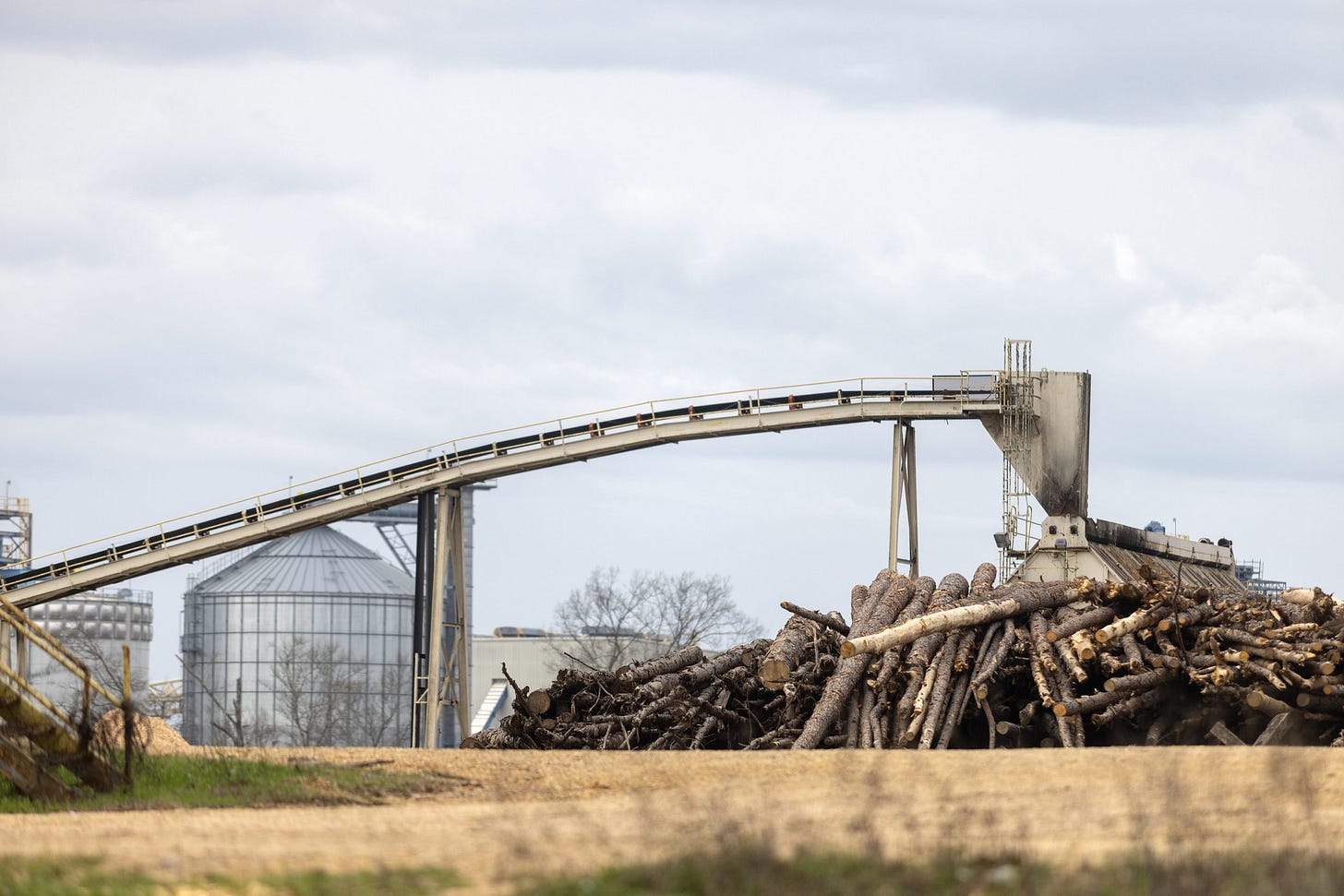Why Climate Pledges (and Vladimir Putin) are Making Life Noisier in Rural America; Ideas for Better-Sounding Cities.
Plus some acoustic odds and ends for your enjoyment
Hello and welcome to the March CLAMOR! This month, we cover the noise and other pollution from the growth of industrial-scale wood-pellet production in the rural southeastern U.S.—spurred by global appetites for “clean” energy and for conquest. Also, some new-ish fixes for city noise, a Clamor flash sale, and trending quiet. Finally, if the sounds of chewing fill you with rage, Yale researchers want to hear from you.
The noisy fallout of good (and bad) intentions

In the last decade, scores of industrial-scale pellet manufacturing plants have popped up in places like Gloster, Mississippi home to around 1,000 people, about 70 percent African American, and more than a third living below the poverty line.
The wood rush was sparked by a 2009 decision by the European Union to classify wood pellet burning as a renewable energy source that could help member nations ditch fossil-fuels. The argument is that the trees made into pellets are replanted, thereby ensuring a long-term offset of the carbon released in the short term. That’s controversial according to many ecologists who argue that cutting down, pulverizing, pelletizing, shipping, and then burning trees at an industrial scale is not clean energy, despite the replanting.
In any case, the subsequent spike in wood-pellet demand left manufacturers hungry for new supplies of wood, which they found in the southeastern U.S. where pine trees are plentiful and so are struggling rural communities eager for development and jobs. Suddenly, the roads in Gloster and similar small towns were filled with heavy trucks bringing logs to the manufacturing plants and then hauling away tons and tons of pellets to begin their journey to Europe. The pellet manufacturing also hit nearby residents with a barrage of noise from grinding, drying, and hammering wood into tiny cylinders, 24 hours a day and 7 days a week.
In addition to noise, both trucks and pellet facilities emit particulates and other air pollution. In 2020, the Mississippi Department of Environmental Quality fined the UK-based owner of Gloster’s pellet plant (Drax Global) $2.5 million for air quality violations. The company subsequently began making investments in Gloster, including $130,000 for a walking track, a holiday turkey giveaway, and STEM programs for local kids. In 2024, they committed $250,000 to a community fund.
Economic Benefits but Public Health Costs
To learn more about the possible fallout from an expanding wood-pellet industry, I spoke with Erica Walker, an assistant professor of epidemiology at Brown University and director of the Community Noise Lab. Last year, Walker won a five-year, $5.8 million grant from the National Institute of Environmental Health Sciences (and then a second grant from the Robert Wood Johnson Foundation) to measure air and noise pollution from pellet plants and other sources across Mississippi, along with their potential effects on a wide range of children’s health problems, from asthma to obesity. Among her partners in this work is the grassroots community group, Greater Greener Gloster.
Full disclosure: I’ve known Walker since 2018 when I wrote a research profile about her for the Boston Globe magazine, which was my introduction to the wide world of noise. Walker was born in Jackson, Mississippi, and for the last several years, she’s increasingly focused on environmental health issues afflicting her home state, including (but definitely not limited to) noise pollution.
Asked about her current work, Walker stressed that she wasn’t out to demonize the wood-pellet manufacturers, which provide a source of needed jobs (including for the region’s tree farmers). Nevertheless, she said there needed to be an accounting of the costs from this and other development, to give communities like Gloster with the information they need to negotiate “good neighbor agreements” in which industries agree to take steps such as enhanced pollution mitigation and sustained investments in communities where they operate.
Walker and her team are spreading environmental sensors in communities across the state, some with pellet manufacturing, some without, and some with other potential pollution sources, such as oil refineries, data centers, or simply crumbling infrastructure. The researchers will analyze these exposures alongside a longitudinal health study of kids—tracking everything from hearing difficulties to respiratory disease to chronic stress to obesity—via health visits to households in each of the communities.
Key excerpts from my interview with Walker are below. They’re mostly audio, except for this first video clip (for the sake of the shared screen) in which Walker described the noises of wood pellet manufacturing.
In 2024, Mississippi was 49th in state-by-state rankings of overall health compiled by the United Health Foundation (Louisiana was 50th). Untangling the reasons for this is Walker’s larger purpose. As she put it, the overarching question driving her research is this: Why are healthy children turning into unhealthy adults in Mississippi?
Walker is also eager to equip local people with the skills and knowledge to keep tabs on their own community’s pollution exposures and to keep fighting for better environmental health long after her grant expires. In the two clips below, Walker explains her wideranging investigation of pollution and the health impacts across Mississippi (clip one covers the environmental sensor data, and clip two is focused on the health study):
How noisy are these pellet plants? According to Walker’s preliminary data, a pellet manufacturing facility adds between 12 and 16 decibels to daily lives of nearby residents, depending on the frequency range measured. “That’s huge,” she said (decibels are a logarithmic measure, so every ten decibels means ten times as much sound energy hitting people’s ears).
Near the pellet plant in Gloster, the DNL (day night sound level; a 24-hour average) was 65 decibels, which is the threshold where the FAA pays for sound insulation in homes near airports. In the following clip, Walker talks about the potential noise impacts they’ll be tracking.
In these final two clips, Walker explains how her research findings could be parlayed into “Good Neighbor Agreements” between wood pellet companies (and other industries) and the communities where they want to operate.
What’s Russia Got To Do With It?
The pellet industry is on track for more rapid growth, thanks in no small part to Russia’s 2022 invasion of Ukraine. That year, the U.S. was already the leading exporter of wood pellets to the EU, supplying more than 3 million metric tons a year, and the war boosted the market for U.S. wood pellets in two ways. First, Russia had been another major wood-pellet supplier for the EU, but that supply dried up completely post invasion. Second, the war scuttled mounting pressure to de-classify wood biomass as renewable energy. European governments became even more eager to wean themselves from Russian fossil fuels, principally natural gas, and so the EU kept “wood biomass” classified as a renewable in its 2023 Renewable Energy Directive.
Last fall, separate from Walker’s research, the Southern Environmental Law Center and a coalition of community and environmental groups in several southern states surveyed people in more than 300 households in five communities located within a 2-mile radius of a pellet plant. Among the findings published in their October 2024 report was that nearly half of respondents were bothered by pellet plant noise every day, jumping to nearly 70 percent in households within a mile of the plant.
More pellet plants are now in the works across the southeast (and elsewhere) to meet the demand, which is also rising rapidly in Asia and North America, leading to growth projections for the global market from an estimated $15 billion currently to more than $21 billion in 2030.
The (not so) Radical Ways to Make Cities Sound Better
City noise problems are as old as cities themselves. From the prohibition of night-time chariot driving in ancient Rome to modern municipal noise codes, most efforts to diminish the din have taken a similar approach—crack down on the sounds that people complain about the most. That’s logical, but it also means that noise battlers are almost always playing catch up, whac-a-moling unwanted sounds, feeding stereotypes of finger-wagging negativity. we can do better in at least two ways.
Without denying the need for traditional noise control, we could do a lot more to proactively avoid noise in the first place with urban design that takes common noise problems into account. Below is a video demonstration by Raj Patel, a leading international acoustics, audiovisual, and multimedia consultant and designer with the firm Arup (video produced by the Wall Street Journal):
Just as importantly, we should also consider the soundscapes we actually want in our cities, not just the noises we want to avoid or squash. New tools being developed at places like McGill University’s “Sounds in the City” lab will let people sonically experience a planned urban space before it exists. With these new tools, city planners, developers, and other stakeholders can listen to a planned commercial district, city park, or plaza as the day passes into night. They can assess the sonic fallout from different design choices, such as placing a water fountain in a park, changing outdoor seating arrangements, tweaking traffic patterns, adding trees, and so forth. After listening, they can make more adjustments and listen again, steering toward a soundscape that enhances rather than detracts from people’s experience of the place. Ideally, these tools would also be used for community engagement and outreach on major developments.
Back in 2022, I interviewed one of the McGill researchers working on this project, a doctoral student named Richard Yanaky. At the time, it was a desktop prototype. But, last month, Yanaky put out a call for people willing to test out a virtual reality version of the project. I’m told he’s likely found all the subjects he needs for that study, but this video gives a flavor of the experience:
Wait…What?!
Acoustic Odds and Ends
Book annoncement! Now through May 20, 2025, the book-discovery platform Tertulia is offering 25% off of Clamor pre-orders. Get in on that deal here.
The number of vacation planners hunting for quiet destinations jumped 50 percent from 2023 to 2024, according to a “Travel Report” from Pinterest that analyzed more than 1 billion travel-related searches. Broader searches related to a “quiet life” skyrocketed by 530 percent over the same period.
March 3, 2025 was World Hearing Day, the tenth edition of awareness raising, free hearing screenings, and other events worldwide dedicated to protecting our ears (organized by World Health Organization). This year, the WHO published new “safer listening” guidelines for video games as well as music, sports, and other entertainment venues.
People with misophonia experience abnormally high levels of anxiety, rage, and stress when they hear chewing, sniffling, throat clearing, or other “trigger sounds.” Sound familiar? If so, check out the recent call for study volunteers by Yale researchers investigating possible genetic underpinnings of misophonia and a menu of other disorders (you don’t need to be based in Connecticut). I heard about the research through the newsletter of Dr. Jennifer Jo Brout, a leader in treating people misophonia.






